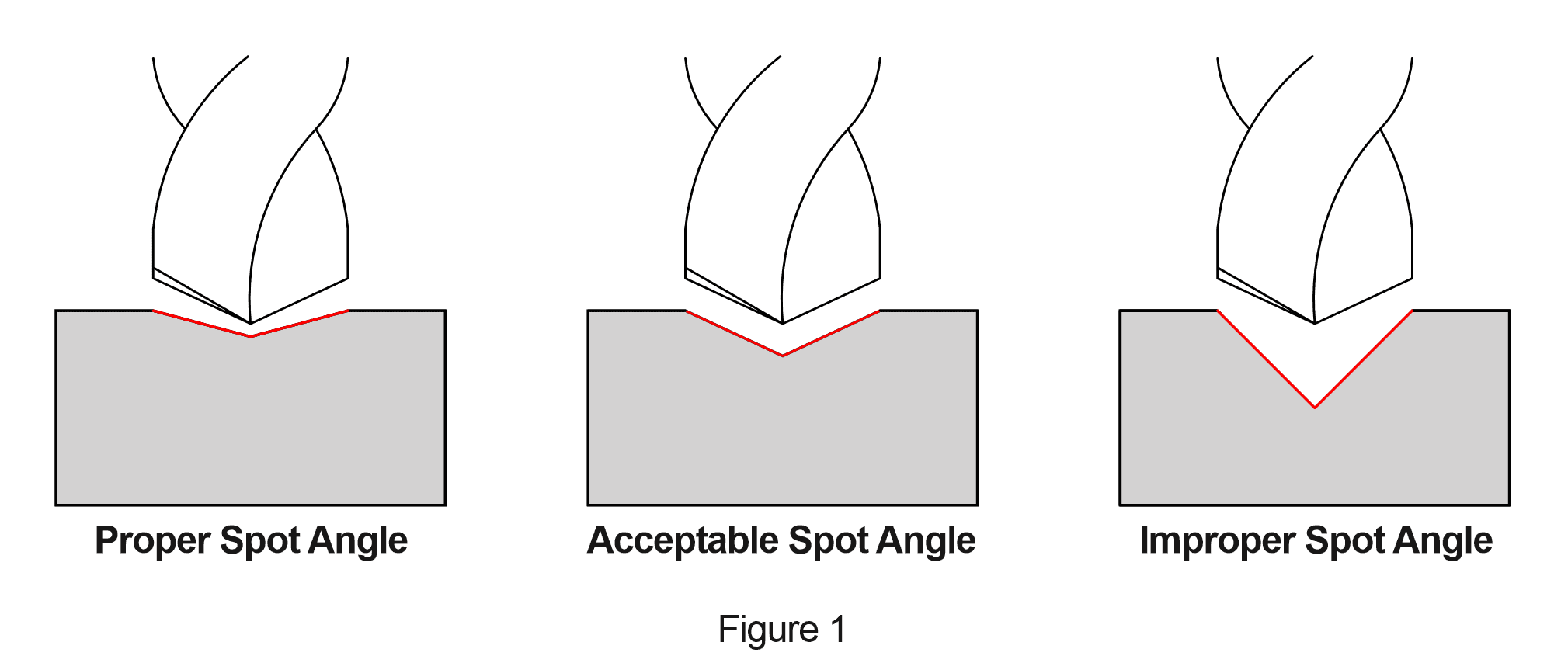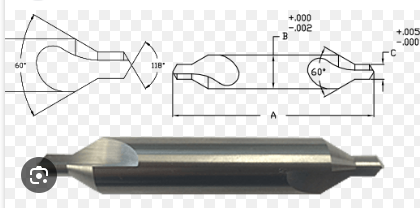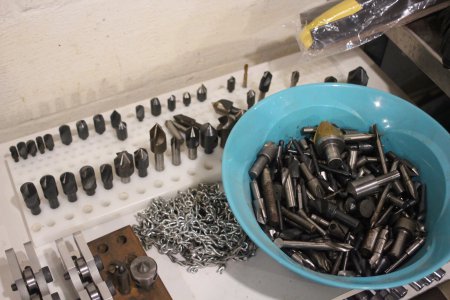-
Welcome back Guest! Did you know you can mentor other members here at H-M? If not, please check out our Relaunch of Hobby Machinist Mentoring Program!
You are using an out of date browser. It may not display this or other websites correctly.
You should upgrade or use an alternative browser.
You should upgrade or use an alternative browser.
Finally Got Some Spotting Drills
- Thread starter MrWhoopee
- Start date
- Joined
- Jun 10, 2019
- Messages
- 534
Yeah, I had also read that a spotting drill should have an included angle slightly larger than your drill so the drill ends up contacting in the center first instead of the lips...hence the 120* and 140* spotting drill angles (and why a 60* center is not ideal). The other idea is that a spotting drill can be selected a larger diameter than the drill, which results in a chamfered hole even after the main drill is used.

Linky
The spotting drills in my collection all have thin webs and/or serious point splitting so they are pretty easy to drill with.

Linky
The spotting drills in my collection all have thin webs and/or serious point splitting so they are pretty easy to drill with.
- Joined
- Dec 24, 2020
- Messages
- 1,038
I recently bought some spotting drills and I'm sold on them. Even the $20 HSS sets off Amazon work just fine (got them to keep at work).
- Joined
- Apr 14, 2014
- Messages
- 3,161
I've been using center drills for spotting since the 1980's. Not because they were better or worse, but because that's what the company bought. They worked fine then, and they still do today. I didn't know I was doing it wrong until the internet came along. That was when all the holier than thous' started telling me what a neanderthal I was, and I should learn to do it the right way. I wasn't impressed by their rhetoric then and haven't changed my mind as of yet. I still like centering drills and use them the vast majority of the time.I had never heard of them before the internet informed me that I'd been doing it wrong all along. Harry taught us to use center drills, Fred did the same. When I looked around for some spotting drills, they were crazy expensive (for what they are). Found these a few days ago and ordered an assortment.
Carbide Spotting Drills
I must admit I did purchase 100 1/4" carbide spotting drills from a member of another board a few years ago. He also threw in 25 3/8" and 25 1/2" drill in the mix just to get rid of them. They were all new in the box KEO brand that were acquired when he bought out a job shop. I don't know what the shop did, but he had over 10,000 spotting drills that he wanted to dispose of.
At $1.00 each they were the least expensive drills I've ever purchased. Every time I open the drawer for one or the other, I more often than not seem to gravitate to the old standard center drill. I've used some of the spotting drills and they work just fine. On the other hand, old habits die hard. I guess I'm destined to be a neanderthal.
Last edited:
- Joined
- Oct 13, 2014
- Messages
- 6,753
Yeah, that's what I figured when I started hearing all the fuss over spotting drills, a few years ago. I mean, I've never had any issues using center drills, all these years and I can't possibly be that lucky...We ( old timers ) were not taught wrong .
- Joined
- Dec 9, 2021
- Messages
- 735
And the supervisor told everyone that you had screwed up the machine and he was a hero for getting rid of you.One of my most favorite shop memories . 1984 I started a position at Ward Manufacturing who made paper machines . I ran 2 G&L HMCs with dual rotary tables and tombstones . All programming and tooling offsets were done in the tool crib . One night I was proving out a set-up and the supervisor came running up asking why I was not running the pot at 100% . I told him I was proving it out . ( the machines had lights on top that flashed if set under 100% ) He grabs the router sheets and says the program is proven and to crank it up . Cool , crank it up ! All went well until a tool change that pulled an 8" 1" diameter spot drill instead of a 2" 1/2" diameter center drill . Jammed the tool change arm on top of the tombstone and more lights flashing than a firetruck . I called him on the radio and asked how he liked THESE lights .I then packed my box and gave him and the company my one finger resignation .

- Joined
- Nov 23, 2014
- Messages
- 2,607
I've read the same thing and typically use a center drill or a 120-deg. spotting drill. The tip of a typical center drill is ground to 118-120, then at the base of the shank a 60 deg angle. A center drill is fine as long as you just hit the tip.Yeah, I had also read that a spotting drill should have an included angle slightly larger than your drill so the drill ends up contacting in the center first instead of the lips...hence the 120* and 140* spotting drill angles (and why a 60* center is not ideal). The other idea is that a spotting drill can be selected a larger diameter than the drill, which results in a chamfered hole even after the main drill is used.

Linky
The spotting drills in my collection all have thin webs and/or serious point splitting so they are pretty easy to drill with.

The thing I can't wrap my head around is that pretty much every center punch I've owned was ground to a 90 deg. point, not something >118 deg. Isn't that the same thing as using a 90-deg spotting drill? Seems to me that a center punch at 90 being pounded into a piece of stock would leave a 90 deg. hole. Then you come back on it with a 118 deg. drill bit? I have no data to support that we're talking "the Emperor's new clothes" here or not, it's more of a case of what you are comfortable with. Ah, the things that keep me up wondering about at night? Should I regrind all of my center punches to 120 . . .?
Bruce
- Joined
- Sep 1, 2023
- Messages
- 490
Given how much kit you seem to have, that would have required a lot of holes!A project I gave up on years ago . Ran out of holes .

I can't judge though, it's only my poor financial management from the past (and only barely sensible management now
- Joined
- Apr 14, 2014
- Messages
- 3,161
Obviously you haven’t come to the conclusion yet that you too may be a Neanderthal.I've read the same thing and typically use a center drill or a 120-deg. spotting drill. The tip of a typical center drill is ground to 118-120, then at the base of the shank a 60 deg angle. A center drill is fine as long as you just hit the tip.
View attachment 485542
The thing I can't wrap my head around is that pretty much every center punch I've owned was ground to a 90 deg. point, not something >118 deg. Isn't that the same thing as using a 90-deg spotting drill? Seems to me that a center punch at 90 being pounded into a piece of stock would leave a 90 deg. hole. Then you come back on it with a 118 deg. drill bit? I have no data to support that we're talking "the Emperor's new clothes" here or not, it's more of a case of what you are comfortable with. Ah, the things that keep me up wondering about at night? Should I regrind all of my center punches to 120 . . .?
Bruce
Common wisdom of the day is that it wasn’t invented or learned in my lifetime it doesn’t apply to the world today.
It’s sort of a regressive learning curve. Not too far from the old adage. “If you don’t learn from history you’ve destined to repeat it”.
Rant over.
- Joined
- Sep 1, 2023
- Messages
- 490
I personally appreciate the level of sarcasm but I'm genuinely unclear as to whether you're a fan of spotting drills or not.Obviously you haven’t come to the conclusion yet that you too may be a Neanderthal.
Common wisdom of the day is that it wasn’t invented or learned in my lifetime it doesn’t apply to the world today.
It’s sort of a regressive learning curve. Not too far from the old adage. “If you don’t learn from history you’ve destined to repeat it”.
Rant over.


